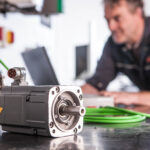Split Phase Electric Motor Repair
Split phase electric motors are used to operate such devices as washing machines, oil burners and small pumps. The single-phase electric motor is generally operated from a single-phase power circuit and it is used in where the requirements of starting torque is moderate. The motor has four main parts. 1) rotor, a rotating part, 2) stator, a stationary part, 3) bracket or end plates and 4) a centrifugal switch located inside the motor.
When a motor fails to run properly, a set of procedure must be followed to determine the repairs required to keep it running.
To determine the malfunction of an electric motor, several tests are performed on the motor, and these tests enable the repairman to determine if the motor needs minor repairs. Minor repairs include new switches, new leads or new bearings. Or whether it requires partial or complete rewinding.
To analyze motor problems, the following steps are given in a logical order to determine what repairs are needed to reset the motor.
1) Motor Inspection
The first is inspecting the motor by detecting such mechanical troubles like broken or cracked end plates, bent shaft badly, burned or broken leads.
Repair shaft:
The shaft is bent normally due to long section or due to improper mounting of shaft. The bent shaft is shown in figure. A bent shaft may be repaired by mounting securely the rotor between the centers in a Lathe machine. Insert the long section of pipe under the bent portion to obtain necessary leverages. To back into position of a shaft, the exerted pressure must be controlled. Usually, it takes little time until the shaft is straight. But this method is only applicable for small rotors other the center of lathe may damage.
End plates improperly mounted
The bearings are out of alignment when the end plate is not fastened securely. To avoid this, the end plate should sound “solid” and should perfectly fit the stator at all points. But if end plate does not fit, the screws should be loosened and each one tightened a little at a time. Thus, end plate should be evenly and securely to the stator.
2) Motor Testing
Test the motor for bearing troubles. To do this, following measures should be taken.
- Try to move the shaft up and down in the bearing as shown in figure 01. Any such movement shows the effect of worn bearing.
Figure # 01
- In order to check the shaft rotation, rotate the motor by hand to see if shaft rotates freely.
- A shaft that does not rotate freely indicates a bearing problem, a tilted shaft, or an improper assembly motor as shown in figure 02.
Figure # 02
- A fuse is likely to burn out should the motor be connected to power line in any case.
3) Ground Test
To check whether the internal wires are touching the iron cores of the rotor or stator or not. This is known as ground test and it is accomplished by using a test lamp.
4) Run the motor
After determining that the rotor rotates freely, the next test is to run the motor. The power lines are connected to the motor terminals and the switch is off for a few seconds. If something goes wrong internally, the fuse may blow, smoke may come out of the winding, or the motor may spin slowly or noisily or may not turn at all. Such symptoms always indicate a problem inside the motor, usually a burned-out winding. The end plates and rotor are then removed, and the windings are carefully inspected. If someone gets badly burned while wrapping up the trouble, the wrapper itself will look burnt and will feel burnt and will also smell.
Rewinding the Split Phase Motor
After previous test have shown that, motor winding is burned out, or shorted. In order to recondition it, rewinding is required. The motor needs to be disassembled in order to repair it. On the front plate and adjacent frame, one center punch mark is made. And on the back-end plate and its corresponding adjacent plate, two marks are made.
There are severely most important operations in order to repair the damaged windings which are to be follow as:
- Taking data
- Stripping the windings
- Insulating the slots
- Rewinding
- Connecting the winding
- Testing and the last one,
- Baking and varnishing
ElectricmotorShopJobs.com keywords: split motor repair jobs, electric motor technician jobs, vibration analyst jobs, electric motor jobs, electric motor shop jobs, split phase motor repair, split phase electric motor repair, split phase technician


